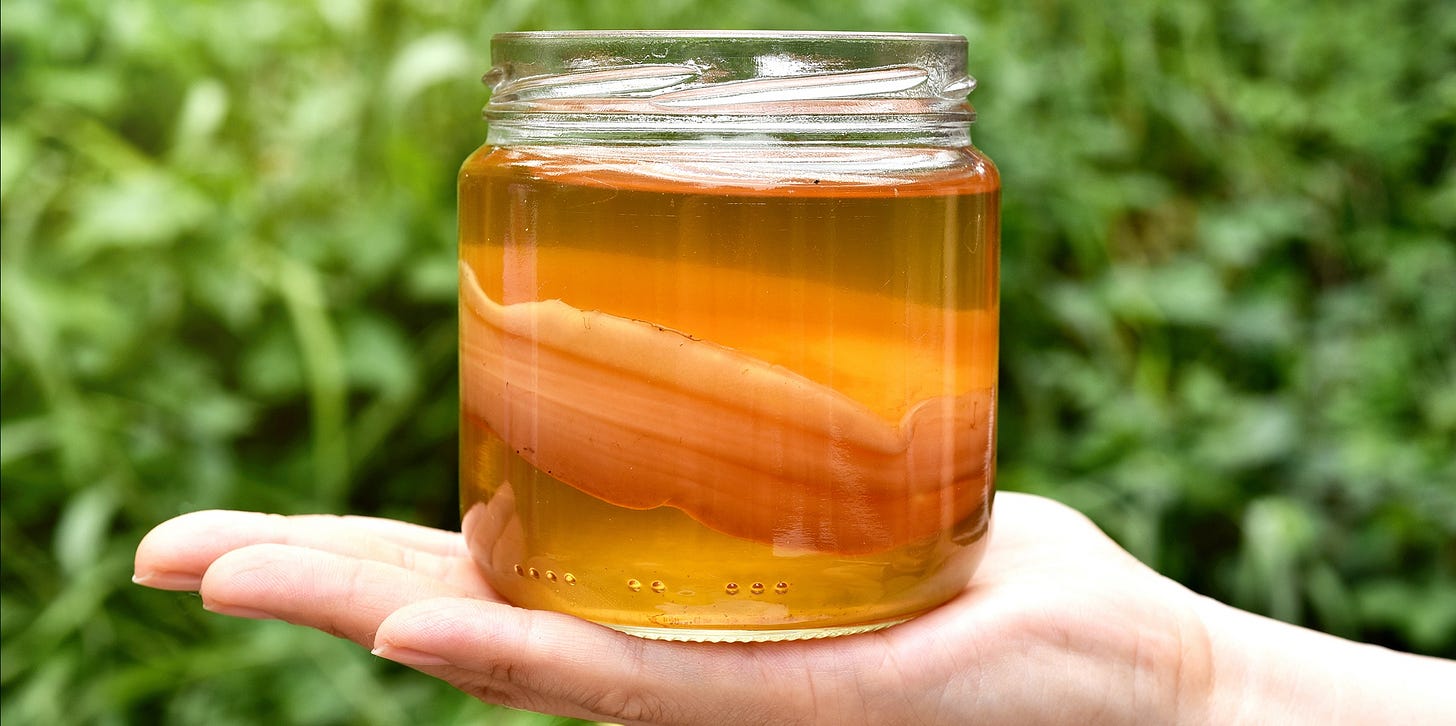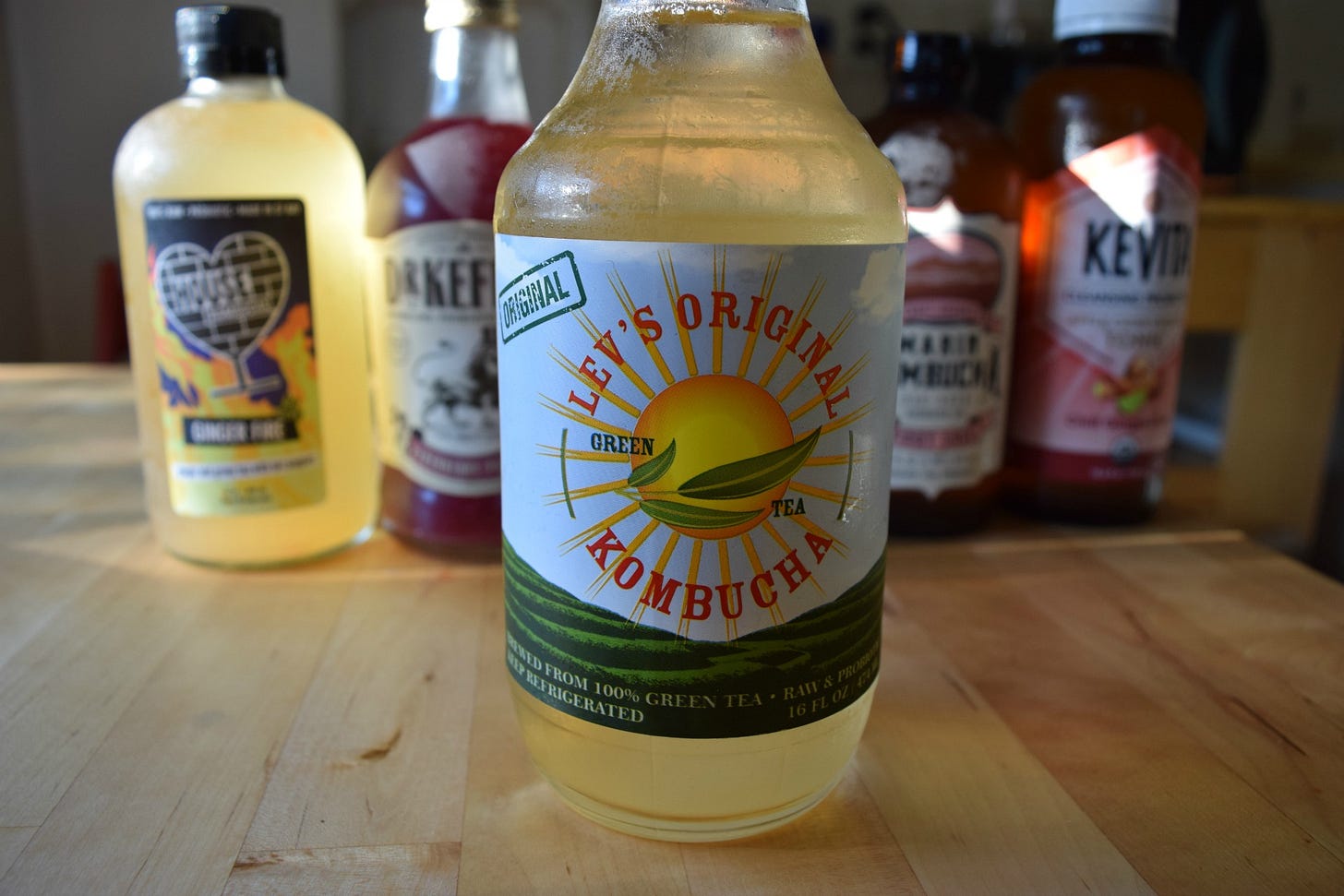Alchemical Wizard 32 : The Microbial Ecosystem of Kombucha!
Kombucha, our new favorite tea fungus or the floating cellulosic pellicle health drink that dates back thousands of years past the Qin Dynasty (221 BCE) in China and is gaining mass popularity among the health conscious in our western world is the subject of our discussion. Not everyone knows that the Japanese name “kombu”-”cha” is a tea cocktail of beneficial microbial products, a culture of bacteria and yeast that coexist within a cellulose, a layered mini Eco-community that they create themselves. It’s not yet known when exactly these cellulose forming bacteria and yeast merged to create the unique symbiotic mini-ecosystem that became a factory for tea beverage production. For well over two thousand years, longevity fans of kombucha have been using this fermented drink to quench their thirst, to increase vitality, boost positive energy and maintain their micro flora balance in their Gut Microbiome!
Why am I bringing all of this up? Not all Kombucha is naturally created equal or with the same bacterial spores and yeast cultures! The SCOBY (symbiotic community of bacteria and yeast), or pellicle are specific bacteria and yeast strains in the kombucha that make it act the way it does, and what produces the fizz and flavor of it. Not all kombucha cultures will contain the exact same strains, but these are some that have been recorded in many studies through DNA sequencing!
1. Acetobacter is an aerobic (requiring oxygen) bacteria strain that produces acetic acid and gluconic acid. It is always found in kombucha. Acetobacter strains also build the SCOBY layered mushroom. Acetobacter xylinoides and acetobacter ketogenum are two strains that you might find in kombucha.
2. Saccharomyces includes a number of yeast strains that produce alcohol and are the most common types of yeast found in kombucha. They can be aerobic or anaerobic (requires an oxygen free environment). They include Saccharomycodes ludwigii, Saccharomycodes apiculatus, Schizosaccharomyces pombe, Zygosaccharomyes, Saccharomyces cerevisiae and my favorite Saccharomyces Boulardii.
3. Brettanomyces is another type of yeast strain, either aerobic or anaerobic, that are commonly found in kombucha and produce alcohol or acetic acid.
4. Lactobacillus a type of aerobic bacteria that is sometimes, but not always, found in kombucha. It produces lactic acid and cellulose excretion.
5. Pediococcus is an anaerobic bacteria that produces lactic acid and cellulose excretion. They are sometimes, but not always, found in kombucha.
6. Gluconacetobacter kombuchae is an anaerobic bacteria that is unique to kombucha. It feeds on nitrogen that is found in tea and produces acetic acid and gluconic acid, as well as building the SCOBY.
7. Zygosaccharomyces kombuchaensis is a yeast strain that is unique to kombucha. It produces alcohol and carbonation as well as contributing to the mushroom layered body.
8. Glucuronic acid is one of the biological body's most important detoxifiers. When toxins enter the liver this acid binds them to it and flushes them out through the kidneys. Once bound by glucuronic acid toxins cannot escape. A product of the oxidation process of glucose, glucuronic acid is one of the more significant constituents of Kombucha. As a detoxifying agent it's one of the few agents that can cope with pollution from the products of the petroleum industry, including all the plastics, herbicides, pesticides and resins. It kidnaps the phenols in the liver, which we talked a little bit about in Alchemical Wizard 25 : Microplastics & Phthalates and How we can live with Less!, and then can be eliminated easily by the kidneys. Kombucha can be very helpful for allergy sufferers. Another by-product of glucuronic acid are the glucosamines, the structures associated with cartilage, collagen and the fluids which lubricate the joints. It is this function that makes Kombucha so effective against arthritis.
TIP : Glucuronic acid or your favorite kombucha especially combined with Turmeric and Ginger root with a dash of ground Peppercorns for more bio-availability is a great anti-inflammatory! Hint : Fire Cider! ( Some of us do better with organic raw apple cider vinegar)
9. Glucuronolactone, glucuronic acid is involved in the metabolism of detoxification in the liver whose glucuronyl rest of the body is linked to a group of foreign compounds or any of the metabolites in the body so that they become soluble in water and are excreted in the urine. Glucuronic acid should be distinguished from gluconic acid because it is linear and the gluconic acid is formed by oxidation of the different carbon glucose atom.
10. Lactic Acid is essential for the digestive system. Assist blood circulation, helps prevent bowel decay and constipation. Aids in balancing acids and alkaline in the biological body and believed to help in the prevention of cancer by helping to regulate blood pH levels.
11. Acetic Acid a powerful preservative that inhibits harmful bacteria.
12. Usnic Acid a natural antibiotic that can be effective against many viruses.
13. Oxalic Acid or Oxalate is an effective preservative and encourages the intercellular production of energy. Oxalate can bind to minerals to form compounds, including calcium oxalate and iron oxalate. This mostly occurs in the colon, but can also take place in the kidneys and other parts of the urinary tract.
14. Malic Acid helps to detoxify the liver. Increases energy levels in our biological body which results in the formation of ATP.
15. Gluconic Acid produced by the bacteria, can break down to caprylic acid, which is of great benefit to sufferers of candidiasis and other yeast infections such as thrush.
16. Butyric acid produced by the yeast, protects human cellular membranes and combined with Gluconic acid strengthens the walls of the gut to combat yeast infections like candida.
17. Kombucha also contains a variety of other nutrients, particularly various acids and esters that give the drink its characteristic tang and fizz. Included in these components is gluconic acid, which is the primary difference between the makeup of kombucha and the makeup of apple cider vinegar.
18. Flavonoids are part of a large class of chemicals called polyphenols that occur naturally in plants. Flavonoids, which are found in a variety of fruits and vegetables as well as in tea and red wine, are thought to boost health in part by combating oxidation. That's why they're called antioxidants! Antioxidants help the biological body's cells resist damage by free radicals. Tea has one of the highest total flavonoid contents of all plants at 15% of the leaf by dry weight!
The actual bacteria, sugar, and acid content of kombucha depends on many factors, including the initial culture, the type of tea leaves used, the type of sugar used, the strength of the tea, the type of water, the brewing time, the culturing temperature, and the location. Due to the nature of kombucha, it is not possible to state an exact microbial eco-system composition. While different SCOBY's may vary in their exact makeup, what is common to all kombucha's is gluconic acid, acetic acid, and fructose!
Here are some of the many health benefits of drinking this ancient and biblical bubbly beverage!
1. Kombucha promotes healthy digestion attributing to the process of fermentation with a live colony of bacteria and yeast. It works as a probiotic by helping in sustaining the gut health and provides relief from various abdominal disorders including chronic constipation and diarrhea symptoms. The digestive enzymes presented in it enhances the effects of glucuronic acid and aiding in the breakdown of proteins and saccharides, thereby making the digestive system more efficient.
2. Kombucha possesses antibiotic properties like bacteriocidal and bacteriostatic which works against a range of pathogens and is used for therapeutic purposes in our biological body's as well as veterinary treatments.
3. Kombucha may have a remarkable ability to detoxify the biological body. It contains a powerful detoxifier glucuronic acid which binds the toxins by entering the liver and eliminates them out of the body via kidneys. Ya!
4. Kombucha contains profuse amounts of organic acids like glucuronic acid and powerful antioxidants which may help in shielding the body from oxidative damage. The antioxidants presented in it looks out for the oxygen free radicals and neutralizes their effects, thereby repairing and protecting the body from diseases and inflammations.
5. Another suggested healing action is that kombucha supports the liver by its hepatic-protective effects. A research study conducted on kombucha has shown that it's tea helps in restoring the levels of glutathione and is remarkably effectual in reducing the induced hepatotoxicity. A comparative study conducted on black tea, kombucha tea, and enzyme processed black tea has proven the efficacy and superiority of kombucha tea in providing hepatic protection against the toxicity attributing to its antioxidant power as compared to the latter.
6. Kombucha tea has anti-microbial properties which may prove effective against a variety of pathogens. An investigative research has revealed that apart from acetic acid, it contains other anti-microbial components which even at neutral values of pH provide protection against a range of microorganisms including Staphylococcus aureaus, Staphylococcus epidermis, Escherichia Coli, Salmonella enteriditis, Pseudomonas aeruginosa, Listeria monocytogens, and Helicobacter pylori.
OK. I hope this helps you do your own research into Kombucha and other fermented foods for benefiting your Gut Microbiome! Our biological bodies first brain is our unique Microbial Eco-system. What are the higher frequency broad spectrum microbial diverse foods that we should be consuming? They are right there in the garden, from the ground, from the vine, from the tree! Cogitate that we are a multi-dimensional light being, utilizing an Avatar that is mostly made up of water and microorganisms held together by an electromagnetic field!
Blessings Everyone as we continue to explore Holistic Health modalities and Nutritional Epigenetics to inspire confidence as we unlock a multitude of resources to make this Ascension shift more meliorative! We are Sovereign and We are most defiantly Freeing Ourselves!
Travis Carper - Ascension Health Coach / Alternative & Holistic Health Service https://www.facebook.com/traviscarper888/ | https://www.linkedin.com/in/traviscarper888/
Additional References :
What is a SCOBY Made Of, and What Are Its Benefits? - https://www.brewdrkombucha.com/blog/kombucha-101-what-is-scoby
Everything You Need To Know About SCOBY Kombucha - https://well.org/nutrition/kombucha/
Kombucha Scoby: Uses, Benefits & Probiotics - https://foodfermented.com/kombucha-scoby/
8 Kombucha Benefits, Plus How to Make This Gut-Friendly Beverage - https://draxe.com/nutrition/kombucha-benefits/
Water Kefir vs. Kombucha: The Ultimate Probiotic Showdown! - https://fermenterskitchen.com/water-kefir-vs-kombucha/
The Health Benefits of Kombucha - https://gtslivingfoods.com/blogs/latest/kombucha-benefits
Kombucha Vs Apple Cider Vinegar: The Ultimate Verdict - https://thecoconutmama.com/kombucha-vs-apple-cider-vinegar
Kombucha vs Apple Cider Vinegar: Which is best for you? Key Differences & Similarities - https://foodfermented.com/kombucha-vs-apple-cider-vinegar/
Apple Cider Vinegar vs Kombucha: 5 Major Differences - https://buchabuddha.com/apple-cider-vinegar-vs-kombucha/
Audio References :
Fermented Food & the Gut Microbiome with Dr. Justin Sonnenburg & Dr. Christopher Gardner - https://www.eatmovethinkpodcast.com/podcast/ep-87-fermented-food-gut-microbiome
Episode 272: More on Histamines & Fermented Foods - https://www.culturedfoodlife.com/podcast/episode-272-more-on-histamines-fermented-foods/
Kombucha Kamp Podcast by Hannah Ruhamah the Kombucha Mamma -






